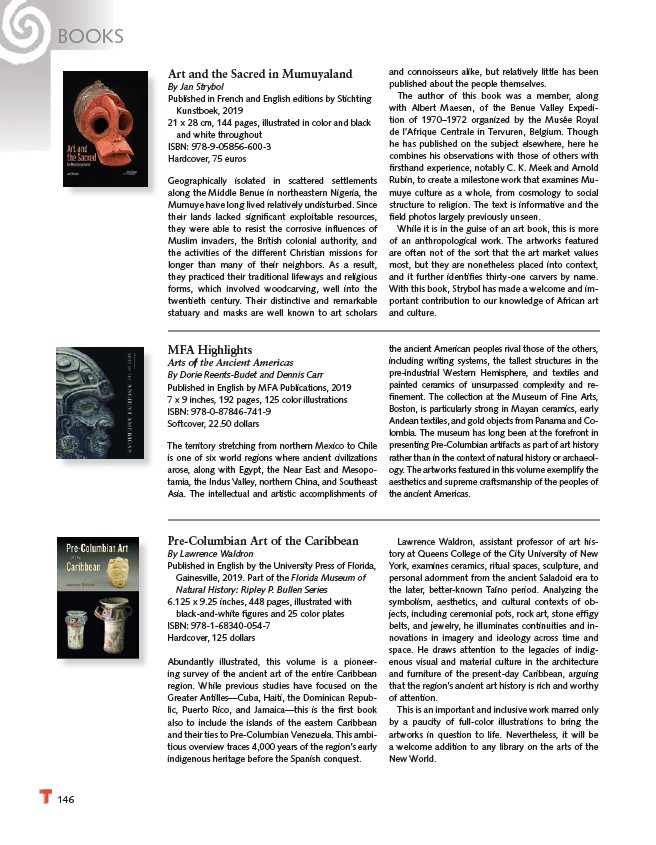
146
Art and the Sacred in Mumuyaland
By Jan Strybol
Published in French and English editions by Stichting
Kunstboek, 2019
21 x 28 cm, 144 pages, illustrated in color and black
and white throughout
ISBN: 978-9-05856-600-3
Hardcover, 75 euros
Geographically isolated in scattered settlements
along the Middle Benue in northeastern Nigeria, the
Mumuye have long lived relatively undisturbed. Since
their lands lacked signifi cant exploitable resources,
they were able to resist the corrosive infl uences of
Muslim invaders, the British colonial authority, and
the activities of the different Christian missions for
longer than many of their neighbors. As a result,
they practiced their traditional lifeways and religious
forms, which involved woodcarving, well into the
twentieth century. Their distinctive and remarkable
statuary and masks are well known to art scholars
and connoisseurs alike, but relatively little has been
published about the people themselves.
The author of this book was a member, along
with Albert Maesen, of the Benue Valley Expedition
of 1970–1972 organized by the Musée Royal
de l’Afrique Centrale in Tervuren, Belgium. Though
he has published on the subject elsewhere, here he
combines his observations with those of others with
fi rsthand experience, notably C. K. Meek and Arnold
Rubin, to create a milestone work that examines Mumuye
culture as a whole, from cosmology to social
structure to religion. The text is informative and the
fi eld photos largely previously unseen.
While it is in the guise of an art book, this is more
of an anthropological work. The artworks featured
are often not of the sort that the art market values
most, but they are nonetheless placed into context,
and it further identifi es thirty-one carvers by name.
With this book, Strybol has made a welcome and important
contribution to our knowledge of African art
and culture.
MFA Highlights
Arts of the Ancient Americas
By Dorie Reents-Budet and Dennis Carr
Published in English by MFA Publications, 2019
7 x 9 inches, 192 pages, 125 color illustrations
ISBN: 978-0-87846-741-9
Softcover, 22.50 dollars
The territory stretching from northern Mexico to Chile
is one of six world regions where ancient civilizations
arose, along with Egypt, the Near East and Mesopotamia,
the Indus Valley, northern China, and Southeast
Asia. The intellectual and artistic accomplishments of
the ancient American peoples rival those of the others,
including writing systems, the tallest structures in the
pre-industrial Western Hemisphere, and textiles and
painted ceramics of unsurpassed complexity and refi
nement. The collection at the Museum of Fine Arts,
Boston, is particularly strong in Mayan ceramics, early
Andean textiles, and gold objects from Panama and Colombia.
The museum has long been at the forefront in
presenting Pre-Columbian artifacts as part of art history
rather than in the context of natural history or archaeology.
The artworks featured in this volume exemplify the
aesthetics and supreme craftsmanship of the peoples of
the ancient Americas.
BOOKS
Pre-Columbian Art of the Caribbean
By Lawrence Waldron
Published in English by the University Press of Florida,
Gainesville, 2019. Part of the Florida Museum of
Natural History: Ripley P. Bullen Series
6.125 x 9.25 inches, 448 pages, illustrated with
black-and-white fi gures and 25 color plates
ISBN: 978-1-68340-054-7
Hardcover, 125 dollars
Abundantly illustrated, this volume is a pioneering
survey of the ancient art of the entire Caribbean
region. While previous studies have focused on the
Greater Antilles—Cuba, Haiti, the Dominican Republic,
Puerto Rico, and Jamaica—this is the fi rst book
also to include the islands of the eastern Caribbean
and their ties to Pre-Columbian Venezuela. This ambitious
overview traces 4,000 years of the region’s early
indigenous heritage before the Spanish conquest.
Lawrence Waldron, assistant professor of art history
at Queens College of the City University of New
York, examines ceramics, ritual spaces, sculpture, and
personal adornment from the ancient Saladoid era to
the later, better-known Taíno period. Analyzing the
symbolism, aesthetics, and cultural contexts of objects,
including ceremonial pots, rock art, stone effi gy
belts, and jewelry, he illuminates continuities and innovations
in imagery and ideology across time and
space. He draws attention to the legacies of indigenous
visual and material culture in the architecture
and furniture of the present-day Caribbean, arguing
that the region’s ancient art history is rich and worthy
of attention.
This is an important and inclusive work marred only
by a paucity of full-color illustrations to bring the
artworks in question to life. Nevertheless, it will be
a welcome addition to any library on the arts of the
New World.